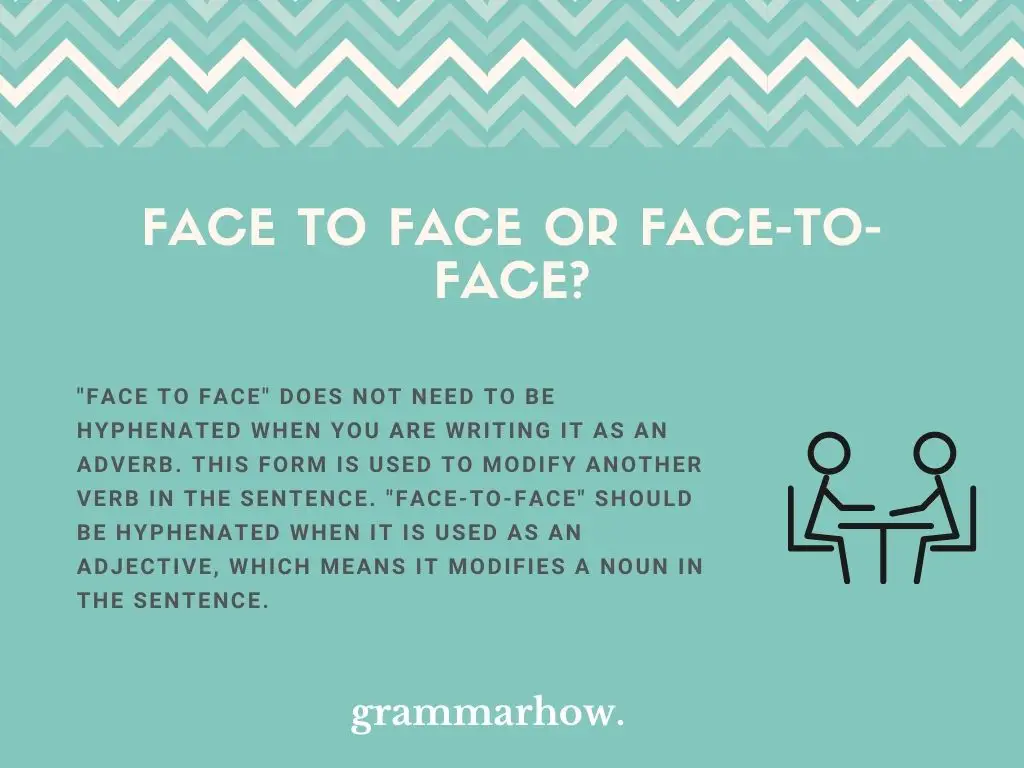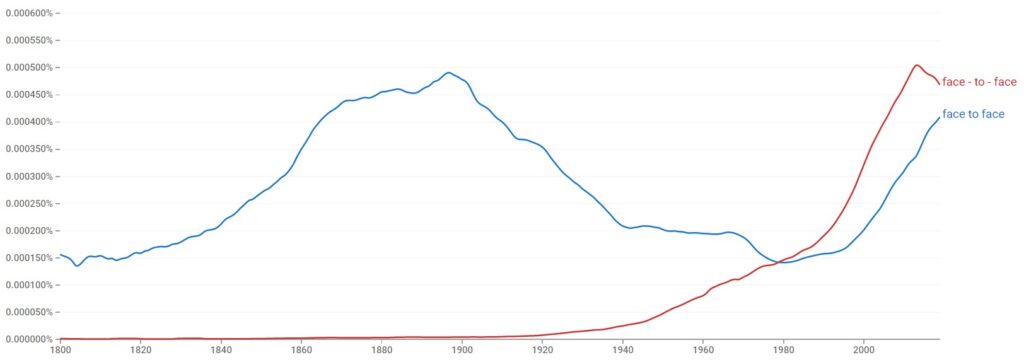If you’re going to write “face to face” in your writing, it will help to know how to spell it. It can be written as more than one or two words, and you might find the hyphenated form useful. This article will teach you all there is to know.
Face to face vs. Face-to-face
“Face to face” does not need to be hyphenated when you are writing it as an adverb. This form is used to modify another verb in the sentence. “Face-to-face” should be hyphenated when it is used as an adjective, which means it modifies a noun in the sentence.

According to Google Ngram Viewer, “face-to-face” is more popular, but there isn’t much in it. This shows that both the hyphenated and unhyphenated forms are correct, and it depends entirely on how you use them.

In The Oxford Dictionary and The Cambridge Dictionary, “face to face” is officially defined as an adverb. This shows that it’s correct to use it without hyphens when modifying a verb.
Both dictionaries also have an entry for the hyphenated form “face-to-face.” This form is marked as an adjective, showing that it’s correct as a noun modifier.
If you’re struggling with the differences between the two, you can refer to these examples:
- Adjective: I will set up a face-to-face interview.
- Adverb: We will do this face to face.
Face to face
“Face to face” is grammatically correct as an adverb. Adverbs are used to modify a verb in the sentence, meaning that an action is given a more specific definition to show what is happening. We do not need to hyphenate it in this form.
You will know when “face to face” is an adverb because another verb should be present. For example, you might see the following:
- I met her face to face.
“Met” is the verb we are modifying here, and “face to face” is used as a modifier. This example shows that a meeting was conducted with both parties appearing in front of each other.
If you’re not quite following yet, you can refer to these examples:
- If you would like to go face to face with her, you should let her know that you’re interested in the idea.
- I think you should meet them face to face. That way, you’ll have a much better idea of their character.
- I don’t like doing things face to face. It always makes me feel uncomfortable because I’m really socially awkward.
- I will see you face to face tomorrow. Until then, I ask that you remain patient and don’t tell anyone about what’s going on.
Face-to-face
“Face-to-face” can be hyphenated when used as an adjective. We use it in this way to modify another noun. Usually, the noun will come directly after “face-to-face,” but you might find in some cases that it’s more appropriate to place it beforehand.
Hyphen rules are clearly established in the AP Stylebook guidelines. We can refer to AP Style to find out that hyphens work as linkers. When more than one word is used to modify the same noun, these linkers allow us to show what the intended target is.
Check out some of these examples if you want to understand more about it:
- She wants to have a face-to-face gathering with all of us, but I don’t know if I’m ready to get back out there just yet.
- If you’re not going to be there for the face-to-face meeting, you need to have a good excuse ready.
- I think it’ll be better to have a face-to-face discussion. Then I’ll know whether it’s worth talking to you about this.
- The face-to-face debate went crazy! I’ve never seen so many people so angry in the same room as each other!
Is “To-Face” Capitalized In The Word “Face-To-Face”?
Finally, let’s see how to capitalize the hyphenated form.
There is no need to capitalize any portion of “face-to-face.” It is not a proper noun, so it does not rely on capital letters. Also, if you start a sentence with it, you do not need to capitalize “to-face” because they can be treated as a continuation of the word.
You might choose to capitalize both parts of the word when writing it in a title. If you capitalize every other word in your title, it would make sense to write “Face-To-Face.”

Martin holds a Master’s degree in Finance and International Business. He has six years of experience in professional communication with clients, executives, and colleagues. Furthermore, he has teaching experience from Aarhus University. Martin has been featured as an expert in communication and teaching on Forbes and Shopify. Read more about Martin here.
